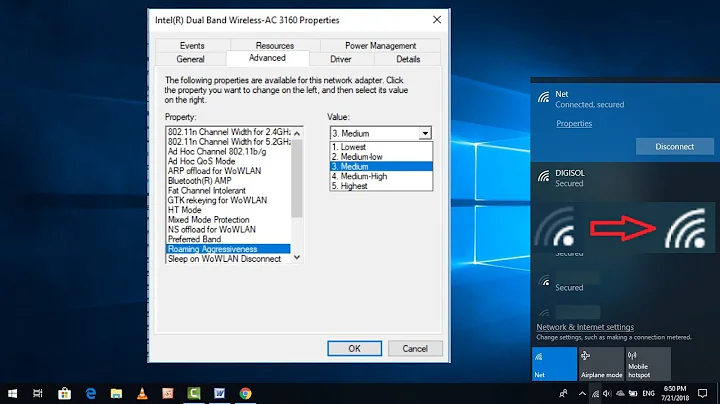Meaning of line-bars in wifi signal strength, dB and negative values?
To understand this means first of all to understand what the signal strength bars actually mean. (Content below copied from this site).
The signal strength is a combination of the actual 802.11x signal + Phone + Microwaves + other sources that might generate 2.4GHz “Noise” + Brain emissions of the user’s anxiety state (j/k), in other words it is visual representation of all the 2.4GHz in the atmosphere around the your Wireless hardware.
I.e. you might see High Signal Strength that Shows: Excellent (5 bars), but it is actually 30% signal + 70% noise.
Such a signal would be the reason for low bandwidth, and or frequent disconnection of the Wireless Network.
In contrast, a medium level Signal (3 Bars) that does not contains any noise would provide a match better connection.
Netstumbler is a free windows tool to see the signal to noise ratio.
If your router is not supported by Netstumbler, then try Kitz - DMT Tool
Db is about a relative number - a reference level if you will. So, unlike S-Unit (often used with radio operators) +db5 is literally half of 10db.
PHY is an abbreviation for the physical layer. The PHY portion consists of the RF, mixed-signal and analog portions, that are often called transceivers, and the digital baseband portion that place high demand on the digital signal processing (DSP) and communication algorithm processing, including channel codes. It is common that these PHY portions are integrated with the media access control (MAC) layer in System-on-a-chip (SOC) implementations. Other similar wireless applications are 3G/4G/LTE, WiMAX, UWB, etc. (Sourced from Wiki)
Related videos on Youtube
JoeM
Updated on September 18, 2022Comments
-
JoeM almost 2 years
If I connect to wifi AP with 1 line of strength, does it mean that I will get only 1/5 of AP's bandwidth?
I mean, do these lines tell me whether I will receive a full bandwidth or only a part of it?
Another questions, what does the dB value of signal mean? Does 100dB equal 100% of the signal? For example, I get 11 dB and 2 lines of wifi strength.
There are also the negative values of the signal, the PHY values. The value for 11dB is -77. Does this mean that the value of 0 equals to 100% of the signal?
thanks for everyone finding time to explain these things to me. I've been using wifi for years but I never paid attention to these things.
-
JoeM almost 12 yearsthanks. can I somehow see the actual ration between the real signal and the noise? I am using win7, but I have ubuntu on other laptop in case win7 does not have such tool.
-
 Dave almost 12 yearsNetstumbler shows the signal to noise ratio; netstumbler.com/downloads (I added this to the body as well for completeness)
Dave almost 12 yearsNetstumbler shows the signal to noise ratio; netstumbler.com/downloads (I added this to the body as well for completeness) -
JoeM almost 12 yearsUnfortunatelly, this tool cannot use Broadcom wifi adapter which is built into my laptop.
-
 Dave almost 12 years
Dave almost 12 years -
JoeM almost 12 yearsthis one works. thanks. can you additionally explain dB and phy values?
-
Everett almost 12 yearsExplanation of decibels: soundonsound.com/sos/1994_articles/feb94/decibels.html It works the same for RF (radio frequency) as it does for sound.
-
rtf almost 12 years"+db5 is literally half of 10db." Decibels are a bit trickier than this. 7dB is half the "power" of 10dB. And perception of decibels to your ears (when the frequency is within hearing range) is a whole different thing too. It's pretty hard to conceptualize a logarithmic curve and put it in to practical application without putting it on paper, at least for me anyway.




